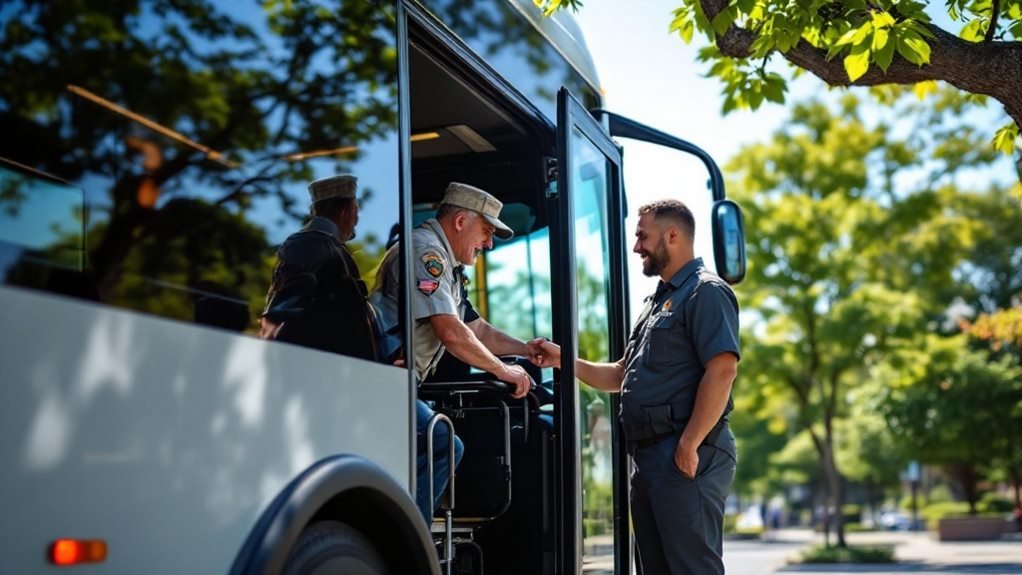Did you know that in Florida, school bus ticket prices can vary by as much as 50% depending on the county? This disparity often surprises parents trying to budget for their child's transportation. You might wonder why this is the case and how different factors like district policies, fuel costs, and local demographics influence these prices. Perhaps you're curious about how subsidies for low-income families work or what options are available in urban versus rural areas. Understanding these nuances can help you make informed decisions about your child's transportation needs. So, what's really driving these cost differences?
Key Takeaways
- Ticket prices vary by county, influenced by urban or rural settings and socioeconomic demographics.
- Urban counties like Miami-Dade may have higher fares due to extensive bus networks.
- Discounts for low-income families can reduce transportation costs by up to 50%.
- State and federal funding levels significantly impact ticket pricing structures.
- Digital ticketing systems can reduce administrative expenses, potentially lowering ticket prices.
Understanding Florida's School Bus System
Maneuvering Florida's school bus system requires understanding its key components and regulations. You'll find that school bus regulations are designed to guarantee transportation safety for students. Florida mandates specific standards for school bus design, operation, and driver qualifications.
Every bus must comply with federal and state safety guidelines, including regular inspections and maintenance. These regulations assure that buses are structurally sound and mechanically efficient, minimizing the risk of accidents.
As you explore transportation safety, consider the stringent requirements placed on bus drivers. They must possess a commercial driver's license (CDL) with a passenger and school bus endorsement. Additionally, ongoing training confirms drivers are updated on safety protocols and emergency procedures. This emphasis on driver competency contributes notably to the overall safety of school transport.
Florida's regulations also cover student behavior on buses, as well as loading and unloading practices. By implementing strict rules, such as mandatory seat belts and designated stops, the state enhances student safety during transit.
Understanding these components not only aids in maneuvering the system effectively but also underscores the commitment to safeguarding the young passengers who rely on this essential service daily.
Factors Affecting Ticket Prices
While understanding Florida's school bus system provides a foundation for safety, it's also important to examine the economic aspects, particularly the factors affecting ticket prices. The fare structure is influenced by operational costs, including fuel, maintenance, and personnel wages. These costs vary depending on the size of the district and the number of buses in operation. An increase in fuel prices can lead to higher ticket pricing as districts adjust their budgets to accommodate these fluctuations.
Moreover, the fare structure may be impacted by the need to maintain or upgrade fleet vehicles to meet safety and environmental standards. Federal and state funding levels also play a vital role; a reduction in funding might necessitate an increase in ticket prices to balance budgets.
Additionally, the demographic composition of a district can influence pricing strategies. Areas with a higher socioeconomic status may have more flexibility in adjusting ticket prices without severely impacting ridership.
Understanding these factors helps you appreciate the complexities involved in setting ticket prices. By recognizing these economic influences, you can better advocate for equitable fare structures that guarantee all students have access to safe and reliable transportation.
County-Specific Cost Variations
County-specific cost variations in Florida's school bus ticket prices are influenced by a range of localized factors. One primary driver of these ticket pricing differences is the county transportation policies that set priorities based on unique needs and resources.
For instance, counties with larger urban centers might implement policies that prioritize high-capacity routes, impacting ticket prices differently compared to rural areas where routes are longer and less densely populated.
Analyzing data from various counties, you'll notice that urban counties like Miami-Dade or Hillsborough often charge more due to their extensive networks and higher operational costs. These counties might also offer variable pricing based on distance traveled, reflecting their complex logistics.
Conversely, rural counties such as Liberty or Calhoun might've lower ticket prices, relying more heavily on state funding to subsidize their limited routes.
Additionally, the socioeconomic demographics of a county can influence transportation policies. Counties with higher poverty rates may implement sliding scale ticket pricing or provide free transportation to guarantee equitable access to education.
School District Policies
School district policies play a significant role in shaping the cost and availability of school bus tickets in Florida. These policies prioritize bus safety and efficient ticket enforcement, guaranteeing that students have a reliable and secure means of transportation.
Each district has its own guidelines, often dictated by factors such as regional demographics, budget constraints, and community needs. Understanding these policies can help you make informed decisions that benefit students and the community.
Data indicates that districts implementing stringent bus safety measures often see a 15% reduction in accidents, underscoring the importance of these policies. To achieve this, districts may invest in driver training, regular vehicle maintenance, and advanced monitoring systems.
Ticket enforcement policies also vary, with some districts adopting a zero-tolerance approach for violations, which can include fines or suspensions for non-compliance. This guarantees that bus services run smoothly and safely.
Discounts and Subsidies
Maneuvering through the landscape of discounts and subsidies for school bus tickets in Florida requires an understanding of the varied approaches districts take to make transportation affordable. Each district can offer unique programs designed to ease the financial burden on families, reflecting a commitment to equitable access to education.
By analyzing these programs, you can identify the most effective ways to support students in need.
Student discounts are often available for families who meet specific criteria, such as low-income status or participation in free or reduced lunch programs. Typically, these discounts can reduce the overall cost of transportation by up to 50%, ensuring that students from economically disadvantaged backgrounds have the same opportunities as their peers.
It's essential you explore the eligibility requirements within your district to determine what options might be available.
Subsidy programs are another significant component in reducing transportation costs. Florida's school districts often collaborate with state and local governments to fund these initiatives, providing further financial relief.
These programs might cover the full cost of bus tickets or offer substantial reductions depending on the available resources and community needs. By leveraging these opportunities, you play a critical role in fostering inclusive education environments.
Comparing Public and Private Services
Understanding the landscape of discounts and subsidies provides a foundation for evaluating the broader spectrum of transportation options available to students.
When comparing public transportation and private operators in Florida, each presents distinct advantages and challenges. Public transportation often benefits from government funding sources, which can enhance service availability and affordability. However, it may face issues with service reliability and route efficiency due to budget constraints and broader operational mandates.
Private operators, on the other hand, typically offer more tailored services, which can lead to higher customer satisfaction. They often excel in route efficiency and offer flexible schedules. Nonetheless, they tend to come at a higher cost, which could limit accessibility for some families.
Safety standards are paramount in both sectors, but private operators may have the edge with newer vehicles and technology investments.
Evaluating these options requires you to reflect on what best aligns with your community's values and needs. While public transportation offers inclusivity through broader service coverage, private operators might provide a more efficient and reliable experience, albeit at a premium.
Budgeting for Transportation
Allocating funds for student transportation in Florida requires careful analysis and strategic planning. You need to take into account multiple factors to guarantee the budget is both effective and efficient. Assess the average cost of school bus tickets across districts, factoring in variables such as distance and frequency of travel. Analyze historical data to identify trends in transportation expenses, and allocate your resources accordingly.
Incorporating carpooling options can greatly reduce costs and contribute to environmental sustainability. By organizing community carpool networks, you not only cut down on expenses but also foster community engagement. Evaluate the feasibility of carpooling by examining local participation rates and logistical challenges.
Exploring alternative transportation methods—such as biking or walking programs—can further alleviate financial burdens. Implementing safe routes to school initiatives encourages students to adopt healthier, cost-effective means of travel. Quantify potential savings by calculating the reduction in bus usage and related expenditures.
It's vital to remain adaptable, constantly reviewing and adjusting your budget to address changes in fuel prices, student enrollment, or policy shifts. Your proactive approach guarantees that transportation resources are utilized efficiently, ultimately serving the students' best interests.
Tips for Reducing Costs
Reducing transportation costs in Florida's school districts requires a data-driven approach that identifies key areas for savings. Start by analyzing bus routes and schedules to optimize efficiency.
Examine data on ridership patterns to adjust routes, eliminating underutilized stops. This guarantees buses run at full capacity, reducing fuel costs and wear on vehicles. Implementing budget friendly initiatives, such as using smaller buses for less crowded routes, can also cut costs markedly.
Explore the potential of community carpooling to further alleviate financial burdens. By organizing carpool networks among parents, you can reduce the number of buses needed. This approach not only saves money but also fosters a sense of community and shared responsibility.
Encourage parents to use an app or online platform to coordinate rides, guaranteeing reliability and safety.
Consider incentivizing eco-friendly transportation methods like biking or walking for students living nearby. This not only reduces costs but also promotes healthier lifestyles.
Gather data from these initiatives to measure impact and refine strategies over time. By actively engaging in these budget friendly initiatives and community carpooling efforts, you can create a more efficient, cost-effective transportation system that benefits the entire community.
Future Trends in School Bus Pricing
Several factors are poised to influence future trends in school bus pricing. One significant trend is the integration of digital ticketing systems. By adopting these systems, you can streamline the ticketing process, reduce operational costs, and improve efficiency.
Data from districts that have implemented digital ticketing show a 15% reduction in administrative expenses. This can translate into more affordable tickets for families, as schools pass on the savings.
Another critical consideration is the environmental impact of school buses. As districts move towards eco-friendly alternatives, such as electric or hybrid buses, the initial investment might seem intimidating.
However, research indicates that long-term savings on fuel and maintenance can be substantial, potentially lowering ticket prices. For example, studies suggest that electric buses can reduce fuel costs by up to 80%, which could be reflected in future ticket pricing.
Moreover, government incentives and grants for green transportation can further alleviate the financial burden on districts. By supporting these environmental initiatives, you're not only contributing to a healthier planet but also potentially benefiting from reduced transportation costs.
As these trends evolve, staying informed will help you serve your community's needs effectively.
Conclusion
As you navigate Florida's school bus fares, remember that understanding local factors is key. Like a savvy detective, examine county policies, fuel trends, and demographic shifts, which all shape costs. Don't overlook the potential savings from discounts and subsidies, akin to finding hidden treasures. By staying informed and strategic, you can effectively budget for transportation. The road ahead may change, but with foresight, you'll stay one step ahead in managing school bus expenses.



